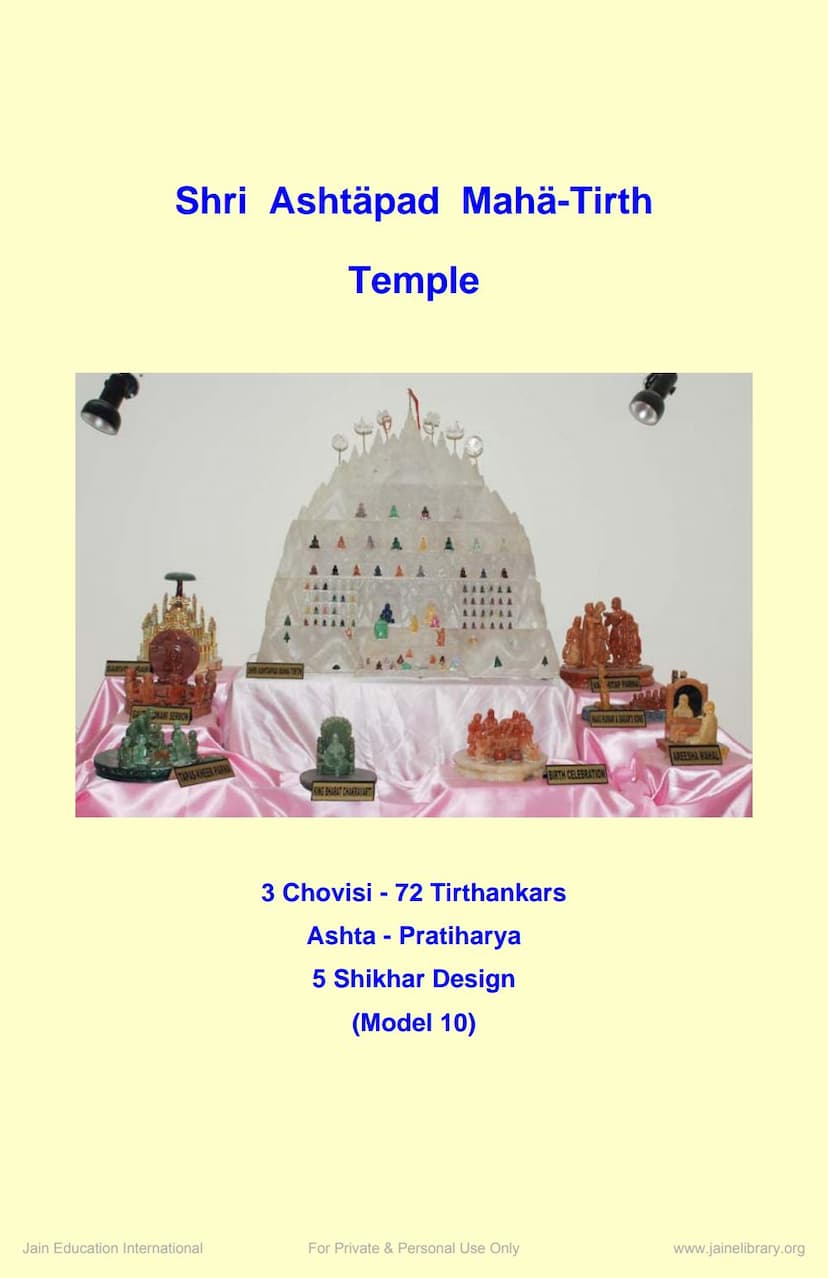JES 981 Ashtapad Tirth Booklet
Added to library: September 1, 2025

Summary
This booklet, "$JES 981 Ashtapad Tirth Booklet" by the JAINA Education Committee, is a comprehensive overview of the Shri Ashtapad Mahä-Tirth, a significant but currently lost pilgrimage site in Jainism. The publication details the religious importance, historical references, conceptual development, and the creation of a detailed model of this sacred place.
Here's a breakdown of the key information:
1. Introduction to Ashtapad:
- Ashtapad is considered one of the greatest lost Tirths in Jainism.
- The Jain Center of America (JCANY) in New York took on the mission to rediscover and represent Ashtapad in the modern era.
- It is a Nirvana Bhoomi (liberation site) for the first Tirthankar, Bhagawan Shri Rishabhadev, who attained Moksha (liberation) there.
- The name "Ashtapad" derives from the eight steps (Ashta + Pad) leading to the palace built there by Chakravarti King Bharat.
- Ashtapad is located in a tranquil region of the Himalayas, identified with Mount Kailash.
2. Religious Significance and History:
- The booklet extensively quotes Jain scriptures, highlighting Ashtapad's mention in texts like Ekadash Angädi Ägam, Ächäränga Niryukti, Sutra Krutängasutra, Uttaradhyayan Sutra, Ävashyak Sutra, Kalpasutra, Nishith Churni, Vividh Tirth Kalpa, and more.
- It details the Pancha Kalyänak (five auspicious events) of a Tirthankar's life and Ashtapad's role as a Nirvana Bhoomi for Rishabhadev.
- The text mentions that all 24 Tirthankars attained Nirvana at five specific places, with Ashtapad being one of them.
- King Bharat Chakravarti, son of Shri Rishabhadev, constructed a memorial palace made of precious stones at Ashtapad to commemorate his father's Nirvana. This palace housed idols of the 24 Tirthankars (Shri Chovisi).
- Scriptural references indicate that those who can scale Ashtapad and stay overnight can attain liberation.
- Shri Gautam Swami, a prominent Jain monk, is described as having scaled Ashtapad using spiritual powers and compiled the initial verses of the Jag Chintamani Sutra there.
- The booklet includes numerous other legends and stories associated with Ashtapad, involving figures like King Sagar's sons, Ravan, Bali Muni, Rani Veermati, and Shri Munisuvrat Swami.
3. Development of the Concept and Model:
- The initial idea at the Jain Center of America was to create a "Ratna Mandir" (gemstone temple) with 24 Tirthankar idols due to space limitations.
- A visit to a temple in Jaipur, where an "Ashtapad Pat" was seen, inspired the shift to creating a model of Ashtapad Tirth.
- The research involved compiling literature from various sources, resulting in 13 volumes of compiled research.
- A field trip to the central Himalayas was undertaken to locate the Tirth.
- The model design emphasizes the snow-covered mountain appearance using crystal quartz, with eight steps and 24 niches (Gokhaläs) for the gemstone idols.
- Religious considerations dictated the seating arrangement of the idols based on scriptural verses, with idols placed in four horizontal rows.
- Structural and engineering challenges were significant due to the weight of the crystal (approximately 10 tons for the final model), requiring a robust steel frame.
- The idols of the 24 Tirthankars are carved from various gemstones, with an emphasis on using single, certified stones. While colors might not perfectly match traditional representations due to gemstone availability, the intention is to reflect religious rules and proportions.
- The model includes Ashta-Pratiharya (eight auspicious symbols) carvings on the Gokhaläs and depictions of related stories in 3D carved units.
4. Research and Probable Site:
- The booklet acknowledges that the actual Ashtapad Tirth has not been witnessed in recent history, leading to ongoing research efforts.
- The probable site of Ashtapad is identified near Mount Kailash in the Himalayas.
- Satellite data and geographical analysis are being used to pinpoint the exact location, with a potential site identified as Gombo Phang or Trinetra or Mahakal, also known as Dharma King Norsang.
- The text mentions a planned Ashtapad Research International Foundation (ARIF) to coordinate global research efforts with geological and archaeological departments.
5. Exhibitions and Outreach:
- The Ashtapad model, 72 Tirthankar idols, and research materials have been exhibited in numerous major cities worldwide (Mumbai, New York, Surat, Antwerp, Palitana, Ahmedabad, Jaipur, Delhi, Kolkata) to educate the public and generate interest.
In essence, this booklet is a testament to the Jain community's dedication to preserving and recreating the memory and spiritual significance of Ashtapad Mahä-Tirth, a lost pilgrimage site rich in history and devotional narratives. It showcases a remarkable effort to bring a sacred, ancient site to life through meticulous research, conceptualization, and artistic craftsmanship.